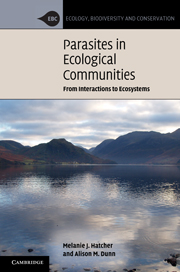Book contents
- Frontmatter
- Contents
- Acknowledgements
- List of abbreviations
- 1 Introduction
- 2 Parasites and competitors
- 3 Parasites and predators
- 4 Parasites and intraguild predation
- 5 Plant pathogens and parasitic plants
- 6 Parasites and invasions
- 7 Ecosystem parasitology
- 8 Emerging diseases in humans and wildlife
- 9 Where do we go from here?
- References
- Index
5 - Plant pathogens and parasitic plants
Published online by Cambridge University Press: 05 August 2012
- Frontmatter
- Contents
- Acknowledgements
- List of abbreviations
- 1 Introduction
- 2 Parasites and competitors
- 3 Parasites and predators
- 4 Parasites and intraguild predation
- 5 Plant pathogens and parasitic plants
- 6 Parasites and invasions
- 7 Ecosystem parasitology
- 8 Emerging diseases in humans and wildlife
- 9 Where do we go from here?
- References
- Index
Summary
Introduction
In this chapter we consider how parasitism of plants affects ecological interactions directly involving plants, and also some of the population dynamic and community consequences for higher trophic levels. We might expect many of the aspects of plant–parasite interactions to mirror those in animal systems; however, in most ecosystems plants occupy the position of basal resource, so plant disease systems are potentially the best place to look for strong knock-on effects at higher trophic levels. Anticipating the results, we might expect to observe parasite-mediated or apparent competition (Chapter 2) between plant species, knock-on effects of plant disease to herbivores (mirroring knock-on effects to predators as discussed in Chapter 3), intraguild predation-like interactions between parasitic plants and their hosts or possibly between different plant natural enemies (mirroring results in Chapter 4), with effects propagating to higher trophic levels (predators of herbivores) and influencing community structure as a whole. Not all interactions involving parasites and plants are considered here: parasites of herbivores (grazers) can also affect plants via (inverted) trophic cascades (Grenfell, 1992; Dobson & Crawley, 1994); these are considered in Section 7.2.
This chapter bridges the gap between the preceding chapters that examine the mechanistic effects of parasitism within community modules (such as competition and predation) and chapters still to come which examine the broader community-level impacts of parasitism.
- Type
- Chapter
- Information
- Parasites in Ecological CommunitiesFrom Interactions to Ecosystems, pp. 176 - 223Publisher: Cambridge University PressPrint publication year: 2011

